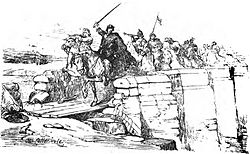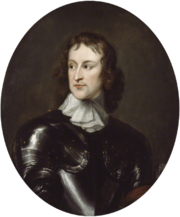Battle of Upton facts for kids
Quick facts for kids Battle of Upton |
|||||||||
|---|---|---|---|---|---|---|---|---|---|
| Part of The Third English Civil War | |||||||||
 The Taking of Upton Bridge |
|||||||||
|
|||||||||
| Belligerents | |||||||||
| Commanders and leaders | |||||||||
| Edward Massey | John Lambert | ||||||||
The Battle of Upton happened on August 28, 1651. It was a surprise attack by a group of soldiers from the New Model Army, led by Colonel John Lambert. They attacked Royalists who were guarding a river crossing at Upton-upon-Severn, about 6 miles (10 km) from Worcester.
During the fight, the Royalist leader, Major General Edward Massey, was badly hurt. The remaining Royalist soldiers were forced out of the town. They had to retreat north along the road towards Worcester.
This successful attack allowed the Parliamentarians to get closer to Worcester from the west. It was a key step in Cromwell's plan to surround Worcester. This battle helped set the stage for the main attack and capture of the city.
Contents
Setting the Scene for Battle
- Further information: Worcester Campaign
When Oliver Cromwell came back from Scotland, he took charge of the Parliamentarian army. This army was fighting against the Royalist forces. The Royalists were camped in and around Worcester.
Cromwell first gathered his troops at Evesham. This place blocked any Royalist attempt to march towards London.
Cromwell's Plan
Cromwell's army at Evesham grew bigger every day. By August 27, his forces were almost twice as large as the Royalists. This allowed him to start the second part of his plan. He wanted to cut off the Royalists from Wales and the western parts of England.
His first step was to take control of the west bank of the River Severn. To do this, on August 28, he sent a strong group of soldiers. This group included both cavalry (horsemen) and infantry (foot soldiers).
Colonel John Lambert led this group. Their mission was to march from Evesham to Upton-upon-Severn. They needed to drive Major General Edward Massey out of Upton. They also had to take control of the bridge and the town.
The March to Upton
Lambert's soldiers marched about 13 miles (21 km) from Evesham. They reached the east bank of the River Severn at Upton that evening. They found the bridge broken.
However, a single plank had been left across the broken parts. A few brave soldiers might be able to cross it. This could allow them to surprise the Royalists. The Royalists were camped on the west bank in the town. Lambert decided to try this risky plan.
Royalist Defenses
Massey, the Royalist commander, was staying in a nearby village. His soldiers were staying in Upton. Some small earth walls had been built. These were between the town and a small stream on the Worcester Road. This made it a strong place to defend against an attack from that direction.
Lambert realized that if Upton was well-defended, it would be impossible to take it easily. There was only one chance: the Royalists might not be watching carefully. Perhaps they didn't know any enemy was close.
Crossing the river was very difficult and dangerous. But if they didn't cross, Cromwell's plan couldn't move forward. So, Lambert decided to take the risk.
The Battle Begins
During the night, Lambert kept his soldiers hidden at Ryall. This way, they wouldn't cause any suspicion or alarm. At daybreak, he chose eighteen of his best men. He ordered them to cross the broken bridge.
As soon as they crossed, they were to find shelter in Upton. Their job was to hold the bridge area until more soldiers could join them.
Crossing the River
On August 29, in the dim morning light, the eighteen soldiers began their mission. It was a very hard task. They had to walk in a single line over a long, narrow plank. It was high above a deep, fast-flowing river. They knew they could be shot at any moment.
When they got onto the plank, they found it hard to face the moving water below. They were in danger of falling. So, they sat down on the plank and carefully moved across it. After some time, all of them safely reached the Upton bank.
Fighting in the Town
Once they formed up, the Royalists saw that they had crossed the river. The Royalists immediately attacked them fiercely. Following their orders, Lambert's men retreated. First, they went into the churchyard. Then, realizing they were too few to defend it, they went into the church itself.
They locked the door and fired through the windows at the Royalists. The Royalists attacked strongly. They pushed up to the church but couldn't get inside. So, they tried to set the church on fire. They also shot at the soldiers inside through the windows. They even tried to stab them with pikes or cut them with swords. The soldiers inside fought bravely. They fired back, causing some losses to the Royalists.
Massey, the Royalist commander, woke up when he heard the firing. He quickly went to his men and directed the attack on the church.
Lambert's Bold Move
It seemed like all eighteen soldiers were doomed. With the Royalists now alert, no one could cross the bridge safely. No one would survive walking the plank under enemy fire. Lambert didn't want to leave his men without trying to save them.
The river was low, and the tide was out. People said it was possible to cross the river by walking, but it was difficult and dangerous. Lambert decided to take the risk. At a spot below the bridge, Lambert ordered his dragoons (soldiers who could fight on horseback or on foot) to enter the river. They had to get across at all costs and help the men in the church.
The dragoons entered the river. They struggled, partly walking and partly swimming, but somehow they made it across.
Royalist Retreat
Once on the Upton bank, the dragoons charged the Royalists from behind. The Royalists were surprised by this sudden attack. At first, they gave way. But then they recovered and charged the dragoons back. They killed several men and many horses.
However, Lambert had found that the river could be crossed. He sent more cavalry across. Soon, the Royalists were greatly outnumbered. They fought fiercely but were forced away from the church by Lambert's larger force. The remaining eighteen soldiers were rescued.
Lambert wasn't satisfied with just the rescue. He wanted to finish the job. The Royalists had retreated into their earth defenses. Lambert ordered his men to storm these defenses. The fight was intense again. The Royalists fought well, but they couldn't get any more soldiers. Lambert's attackers kept growing in number.
Planks had been placed over the broken bridge arches. This meant more troops could now easily cross into Upton. Massey, who had already had one horse shot from under him, now fell, badly wounded.
The Royalists were discouraged. Their leader was hurt, the enemy numbers were growing, and the attacks were constant. The 300 Royalist soldiers finally gave up. Lambert's men took the earth defenses. The Royalists left their camp, supplies, and wounded. They ran away as fast as they could along the Worcester Road.
It was said that the retreat was so complete that each horseman picked up a foot soldier behind him to escape faster. However, this might not be entirely true. Very few Royalist prisoners were taken. Also, Massey managed to get back to Worcester safely. He was so badly wounded in his head and thigh that he needed help to stay on his horse and could only move at a walk.
After the Battle
The fight at Upton was sharp and quick. Lambert earned his victory by bravely carrying out his orders. He also held onto Upton tightly once he got a foothold there.
According to historian J.W. Willis-Bund, no braver act is recorded in all the Civil War fighting in Worcestershire. He was talking about the 18 soldiers who crossed the bridge. They held the burning church against 300 Royalists. This allowed Lambert to win his victory.
Impact on the War
The battle also allowed the Parliamentarians to move around the Royalist forces. This cut off the Royalists from Wales and the west. It was also the first step in pushing back and crushing the Royalists' right side. This allowed the surrounding movement to begin. It also helped to get around the strong defenses the Scots had built around Worcester.
Cromwell thought this battle was very important. This is shown by the fact that he came to Upton later that day. He thanked Lambert's men for their brave actions. He also made sure their victory was used to its best advantage.
Cromwell ordered the bridge to be fixed right away so troops could cross. The same day, he sent his second-in-command, General Charles Fleetwood, to take charge at Upton. He ordered Fleetwood to march there with a large force of about 12,000 troops. This included all of Colonels Lambert's and Deane's brigades.
The next day, a large Parliamentarian force was camped on the west bank of the Severn. Their forward guards were pushed to the Old Hills and almost to Powick. Their scouts (called vedettes) were sent up the Teme valley. This was to stop any attempts by the Royalists to communicate with Wales or the west.
Images for kids




